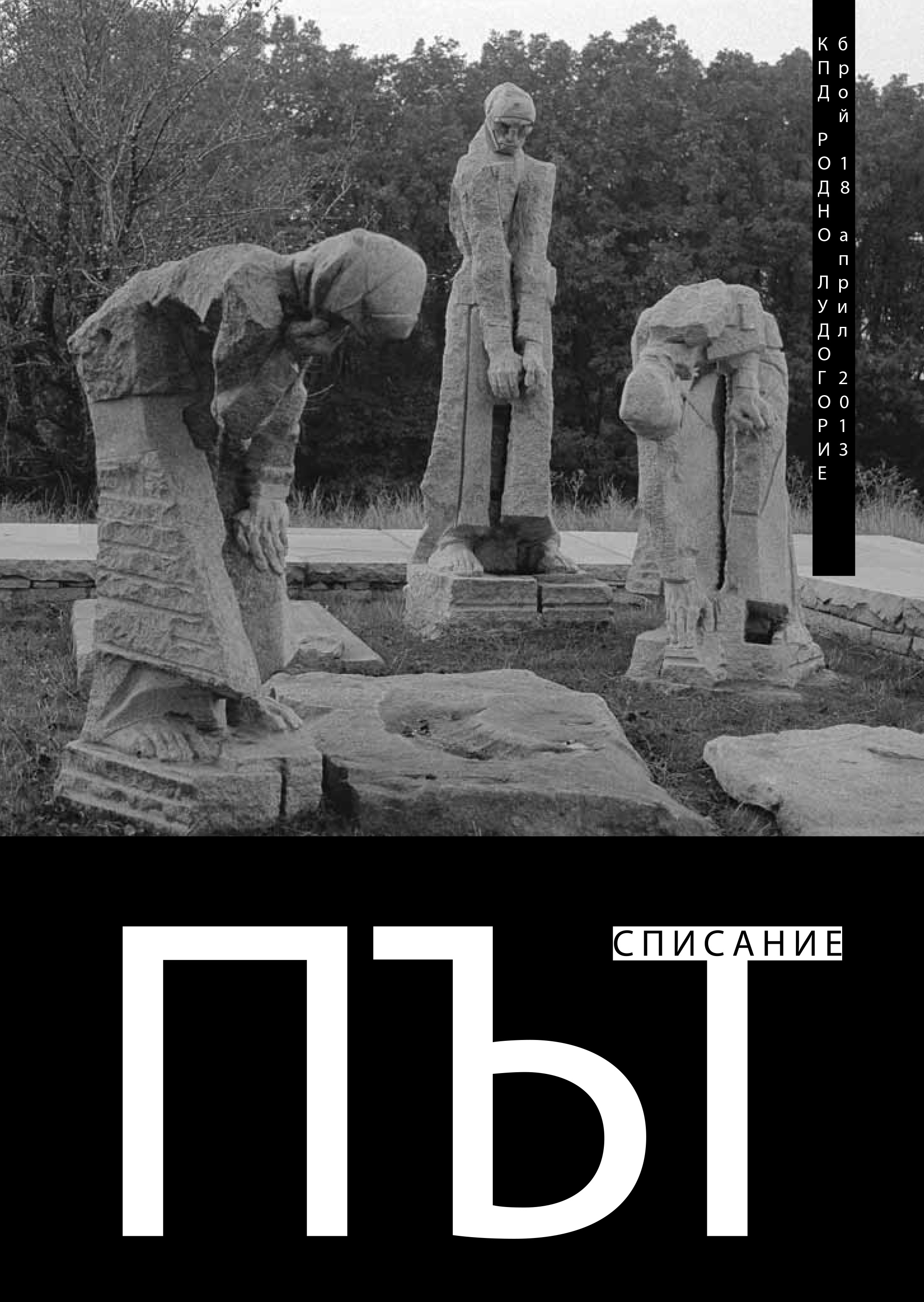
Историците - жреци на Клио или нейни господари
Conversation between Dr. Anatoli Kanev and Prof. Ilia Todev about the role of historians and more specifically the history of Batak.
More...We kindly inform you that, as long as the subject affiliation of our 300.000+ articles is in progress, you might get unsufficient or no results on your third level or second level search. In this case, please broaden your search criteria.

Conversation between Dr. Anatoli Kanev and Prof. Ilia Todev about the role of historians and more specifically the history of Batak.
More...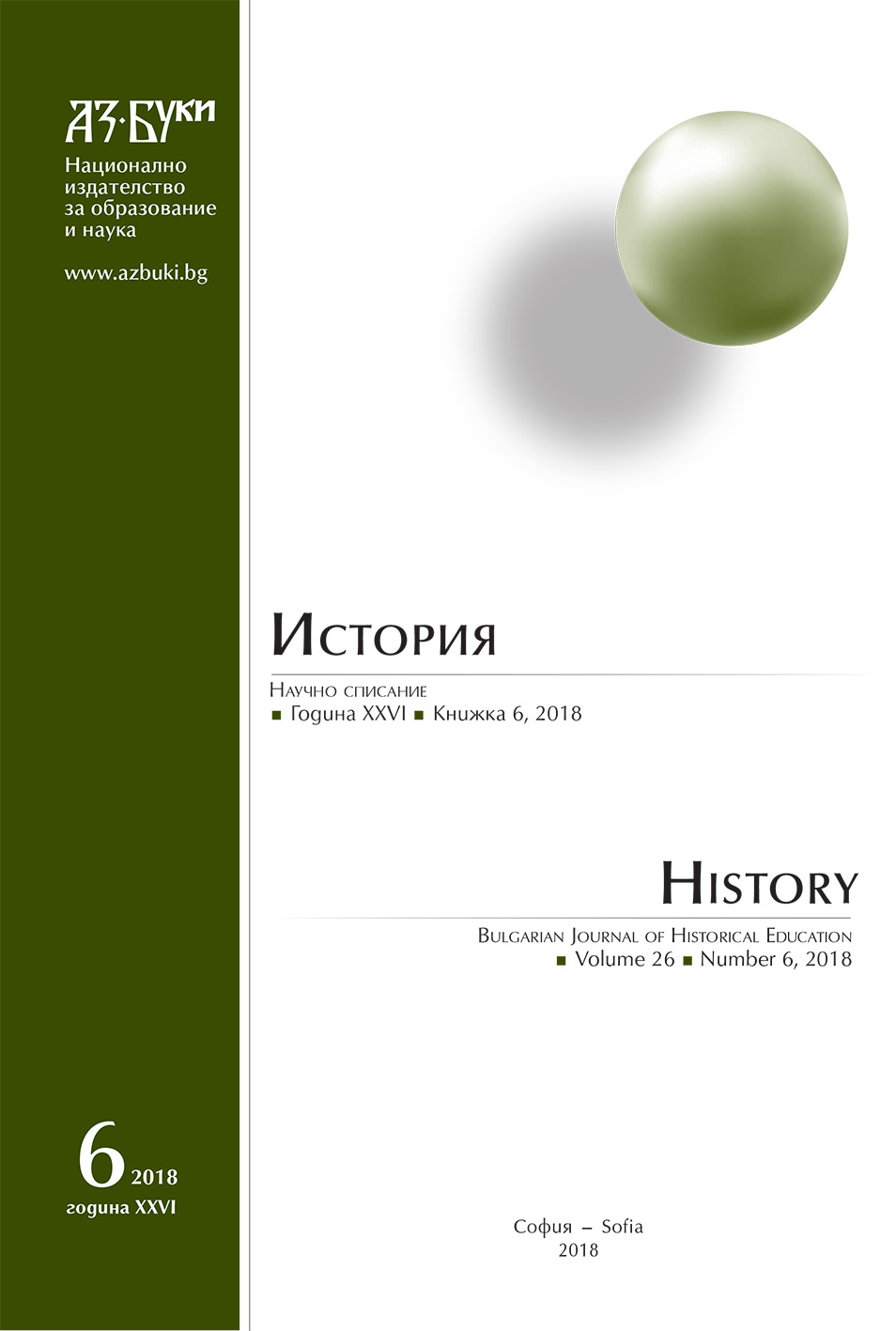
Integration process in the region of East Asia is a relatively new phenomenon in comparison with Europe or America. The idea for deepening East-Asian regional cooperation emerged during 50s and 60s of XX century. Nevertheless, East Asian countries were not ready to take steps in that direction yet. Although a few South East Asian countries managed to establish in 1967 first successfully operating regional organization – ASEAN, real attempts for deepening regionalism and integration, including East Asian countries, appeared after the end of the Cold War. This study aims to outline Beijing, Tokyo, and Seoul’s basic views on development of East Asian integration and to analyze similarities and differences between them. The study also attempts to explain what really prevents East Asian countries to achieve comprehensive and effective integration of the region.
More...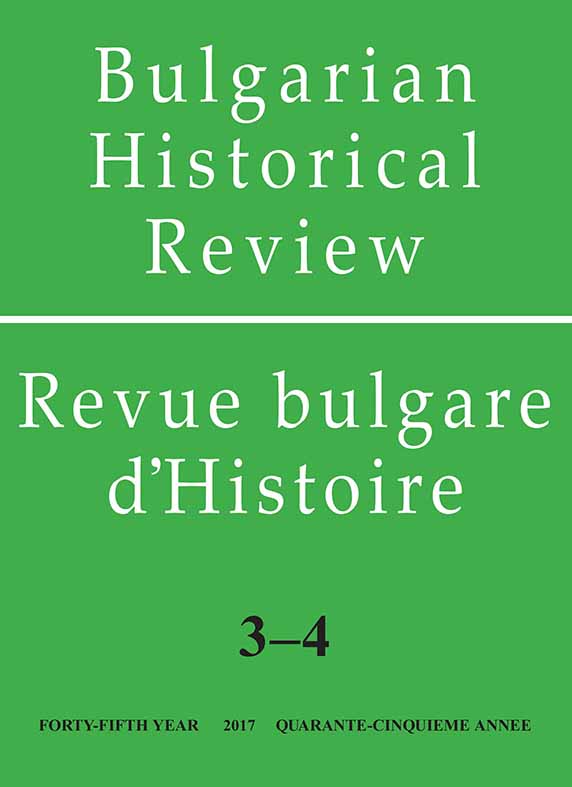
A major objective of this article is to reveal the essence of the concept of Bulgaria’s healthcare policy in the period from 1879 to 1912. It is based on a detailed study of the debates accompanying the preparation, discussion and adoption of all laws related to healthcare in post-liberation Bulgaria. Their analysis makes it possible to conclude that the formation of the basic concept of this kind of policy began already with the establishment of the first governing structures in the territories liberated by the Russian troops. At its core were the aspirations of the authorities to regulate all the necessary care that the state had to take to improve the health and to reduce the mortality among the population. It was of decisive importance for the realization of this process and for the gradual increase of the life expectancy of the population inhabiting the country.
More...
Despite the popular feature of Bulgaria as the most faithful satellite of the Soviet Union during the Cold War, Sofia used cleverly different mechanisms to attract Moscow’s support to ensure national security. One of them was the emphasis on the image of the most loyal Soviet ally, and in the practice of Bulgarian diplomacy one could see the subtle impact by referring to common goals with the global strategic plans of the USSR. The article highlights some of the outstanding issues on the Balkans and follows the arguments that the Bulgarian political leadership handled, as well as the acceptable compromises it was willing to make to ensure Soviet support in favor of national interests in the years of the preparation and conduct of the Conference on Security and Co-operation in Europe.
More...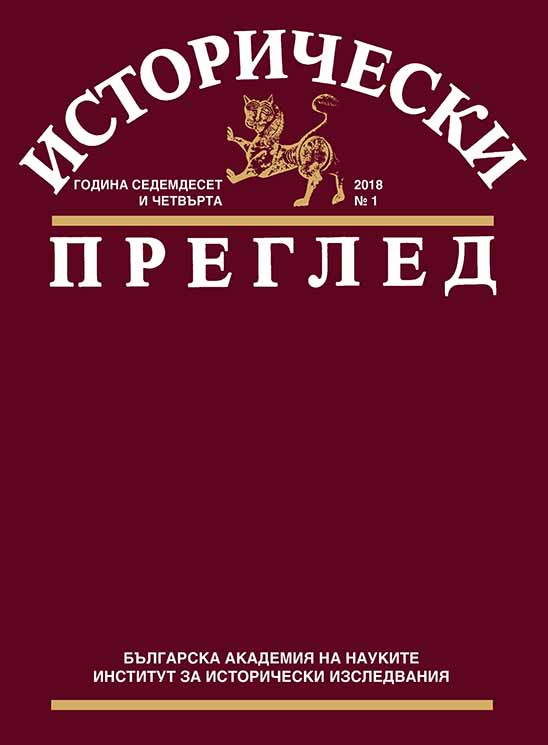
Book Review: "Naimushin, I. N. Naval Engineering School of Emperor Nicholas I, 1898-1919."
More...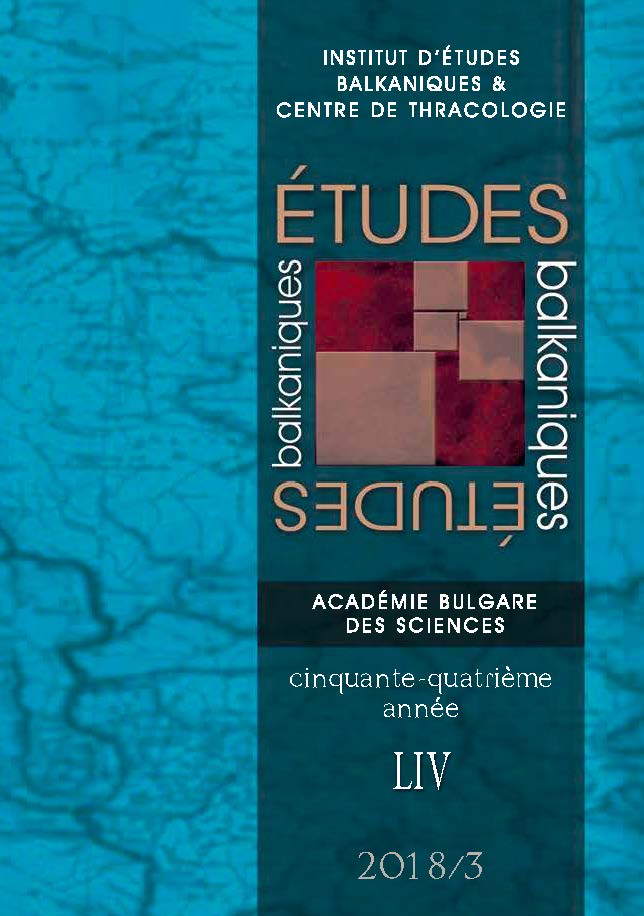
As a cosmopolitan port city imbued with various cultures in the Levant, Salonica took its share from the modernization efforts triggered with Tanzimat Period. By mid-nineteenth century, Salonica’s embankment and customs facilities were limited and the transport of goods was problematic due to limited access. Meanwhile, burgeoning trade activities as a result of Ottoman treaties granting special privileges to foreign tradesmen necessitated a comprehensive reorganization of the harbour area.This paper aims to study the urban and architectural transformation of the commercial centre of the city, with a special focus on the re-organization of the sea shore supported with new findings from the Ottoman archives. After its completion in 1882, Salonica Quay became the most prestigious area of the city, lined with buildings which represented the transforming socio-economic life. The urban transformation emerging from the quay area also reflected on the traditional commercial centre concentrating around Frank Street, where new types of commercial buildings started to appear.
More...
Scholars have relied upon diverse methodologies and sources to produce a new corpus of studies about Salonica’s Jews that explores the impact of the end of the Ottoman Empire and the consolidation of the Greek nation-state. Much of the newer scholarship, however, reinforces the perception that Salonica’s Jews experienced a period of “decline” after the city’s incorporation into the Greek state (1912 – 1913) that culminated in their deportation to Auschwitz (1943). This study investigates why such a lachrymose and teleological interpretation of Salonican Jewish history persists today. By reference to new sources and a different interpretive lens, this article also challenges conventional wisdom concerning key turning points in the narrative of the city’s Jews: a major fire (1917), a compulsory Sunday closing law (1924), and the first major act of anti-Jewish violence (1931). The article thus offers a new approach to assessing the encounters between the multiplicities of Jews in Salonica and the Greek state.
More...
Bouena Sarfatty was born in Salonika in 1916 to a Sephardi family. After World War II, she memorialized her birthplace by composing hundreds of Ladino verses (coplas) about Jewish life in the twentieth century. Her phenomenal memory and personal insights provide a poetic mirror that reflects the multi-cultural environment which she experienced personally. The poems appearing below reflect her thoughts about the process of modernization, whether of language, education, dress or mentalité. European influences created a cosmopolitan city that clearly affected Jewish life. The changes that transpired following the devastating fire of 1917 often harmed the development of this community that had been so vibrant and essential for centuries. Be that as it may, the poems written by this native Salonikan present a unique glimpse into the mindset and experiences of multilingual Jews attempting to adapt to the twentieth century and life in a multi-cultural city.
More...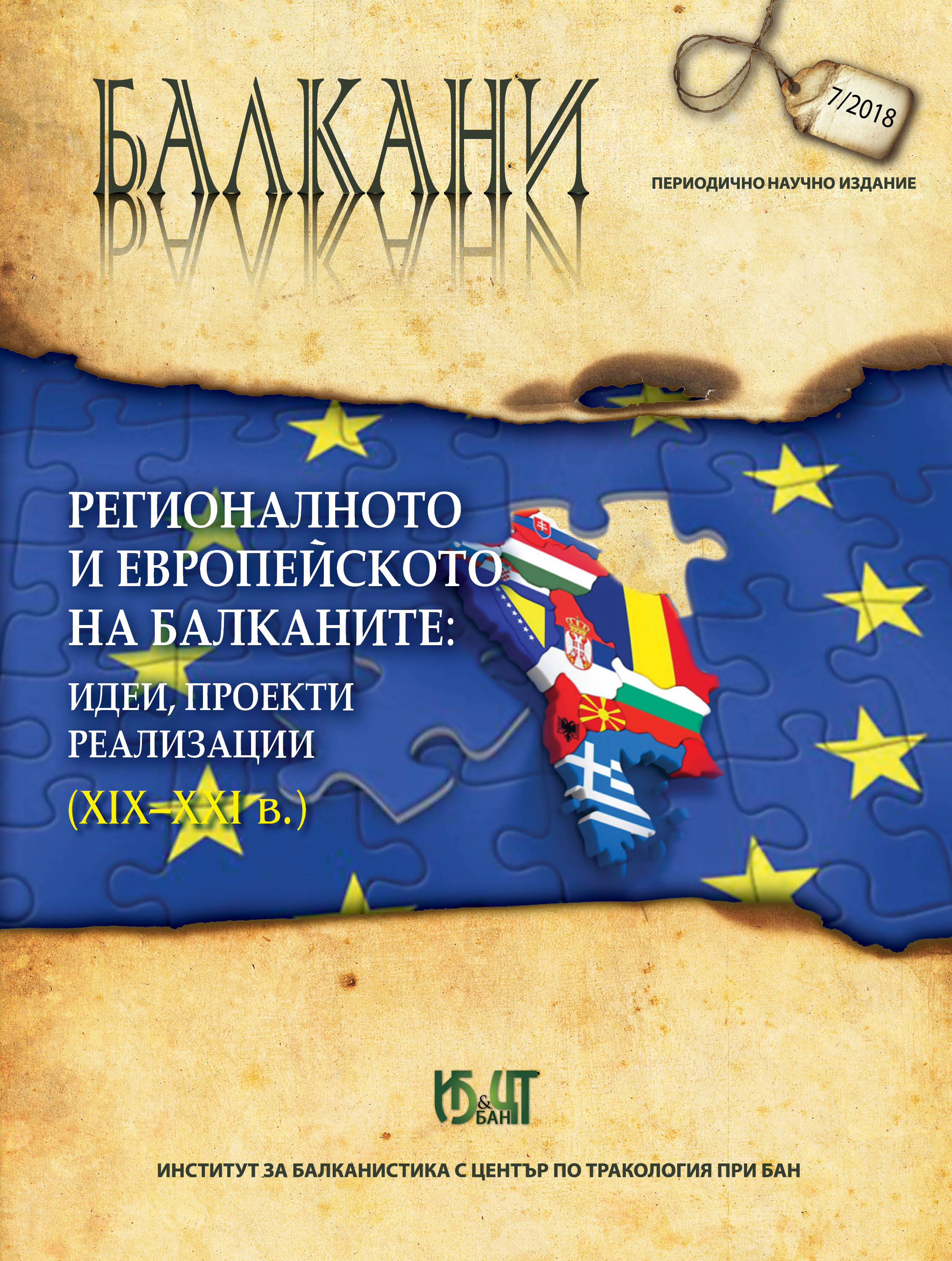
This article is dedicated to the modernization in the Republic of Turkey that took place from its establishment in 1923 until the end of the 20th century. It analyzes Mustafa Kemal’s approach to modernization, which has imposed a radical separation with traditional Islamic values and Ottoman tradition. Despite the quick enactment of a European legislation and the restructuring of the country to a European model, the change in Turkish people’s identity has not been without difficulty. Alongside the introduction of a multiparty political system, the traditional Islamic values have made their way into the political scene, and shortly thereafter the Turkish army begins to intervene directly in political life as a guardian of the secular nature of the state, but at the same time undermines its democratic foundations. The movement toward a liberal political life during T. Özal’s administration has irreversibly shifted the direction of Kemalist Turkey’s development. The necessity of the merging of Islamic cultural identity with European values has sparked a public debate, marked by an uneven advancement, testing the country’s worldly stature.
More...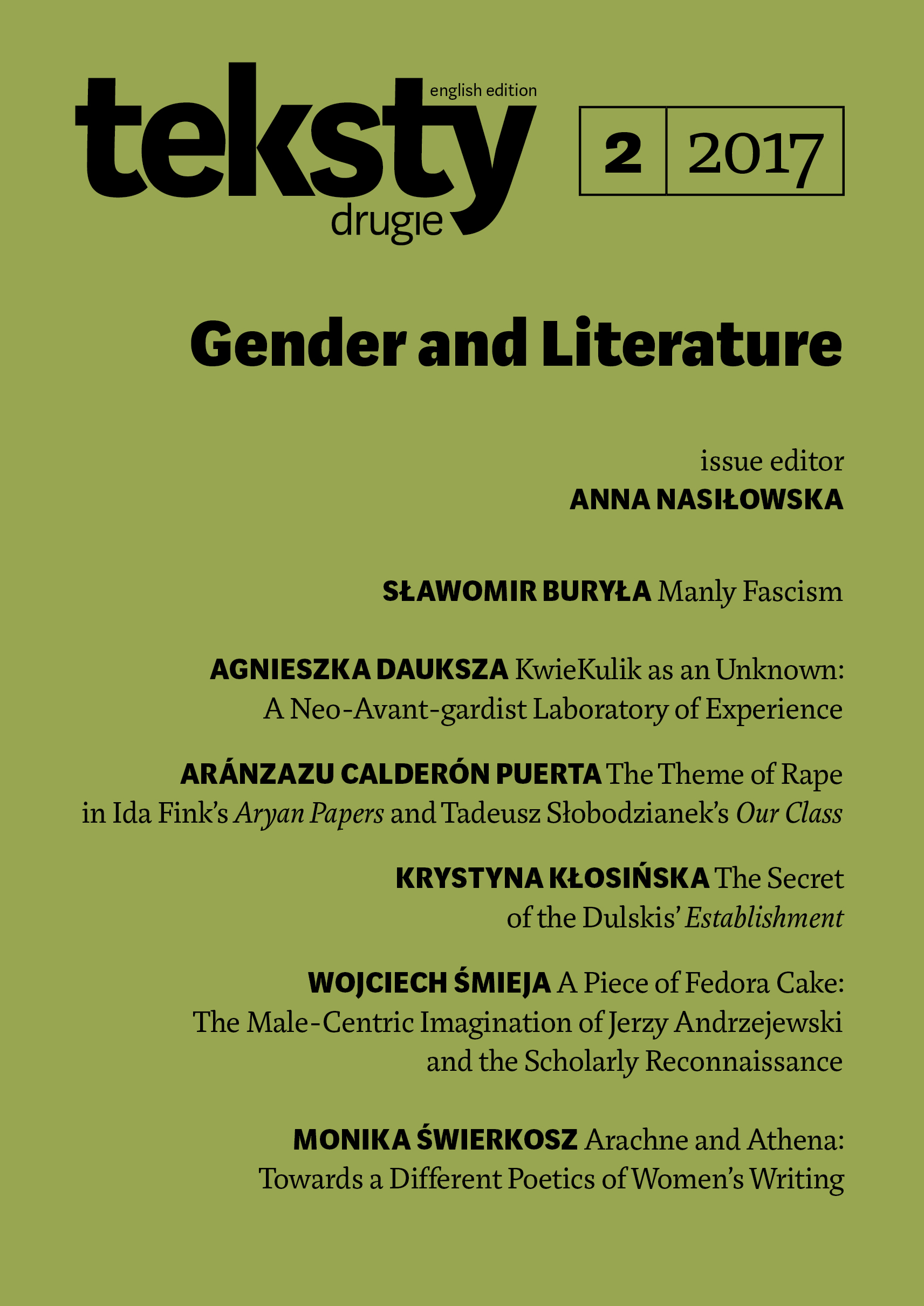
The article analyses the ways in which Central European postwar societies produce gen¬dered representations of Holocaust stories. Calderón Puerta shows how sexual violence functions in culture, highlighting the different ways in which it can be represented in literary texts: it can be understood as a symbol of relationships between antagonistic communities of men (what Roland Barthes refers to as mythologization), but it can also be seen to symbolize the continuum of violence in patriarchy (violence against specific women, structural violence and symbolic violence). Calderón Puerta argues that the different ways of understanding the representation of rape are related to the difference between masculine and feminine points of view.
More...

Buryła discusses how fascism relates to the concept of masculinity in popular and stereotypical representations of fascism and of the Nazi torturer. He also analyses the ways in which the executioner is erotized in film and literature. Finally, he explores the sources and dimensions of the Nazis’ fascination with masculinity – a fascination that led to the male’s dominant position in Hitler’s ideology.
More...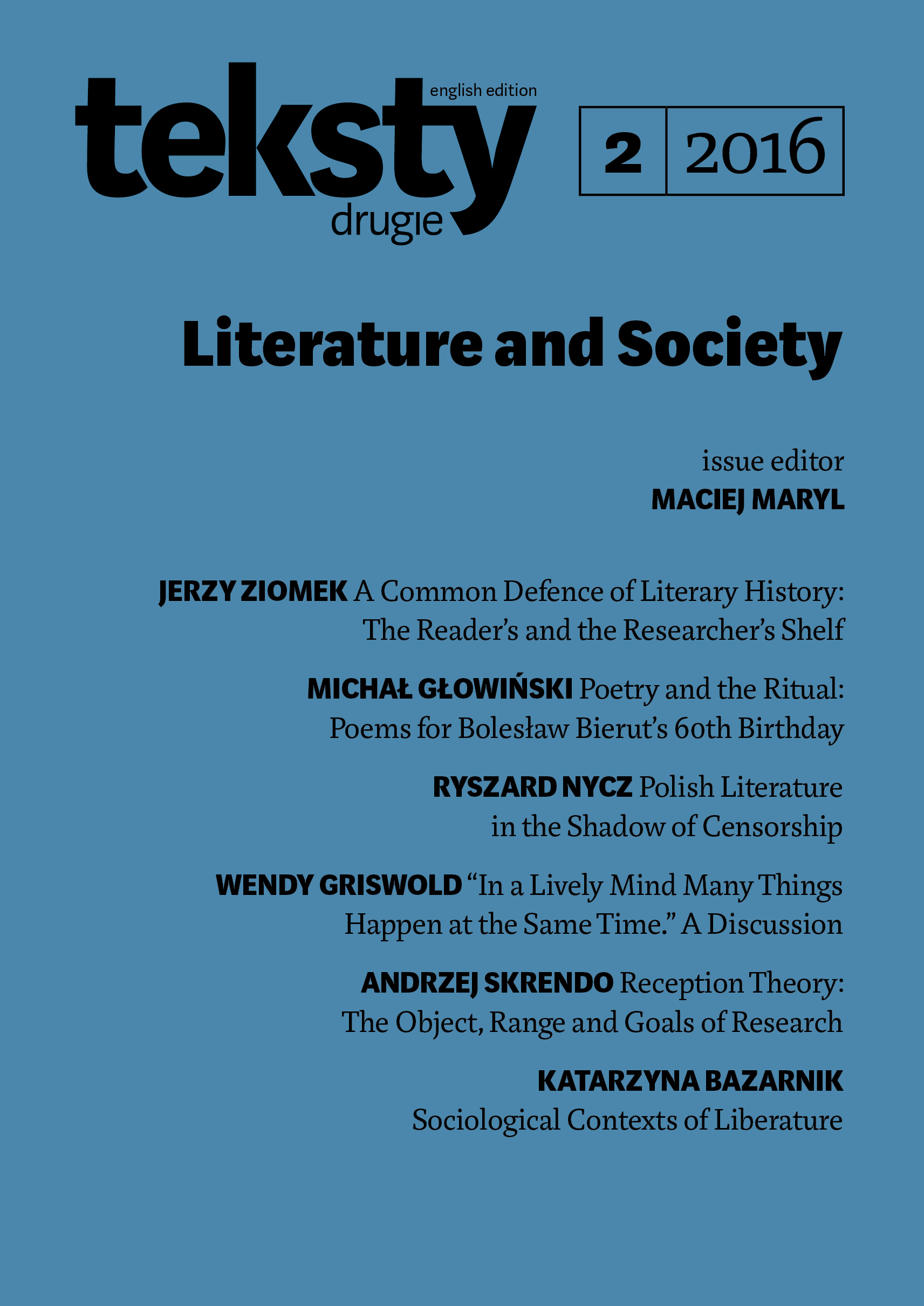
This article discusses the processes of bringing translations of literatures from nations on the (semi)periphery to the German publishing market. Using Dutch and Polish literatures as case studies, and drawing empirical data from the archives of the publishing house Suhrkamp Verlag, covering the period from the early 1960s until 1993. Zajas examines what aspects of the German publishing landscape have propelled Dutch literature to a relatively prominent position in the second half of the twentieth century, while literary translations from Polish came to only about half the number and were thus relegated to the periphery. Latour’s actor-network theory (ANT) allows Zajas to broaden the theoretical scope of the scholarship on the social and organizational conditions of translation.
More...
The authors analyse the relationships that came into being within the literary field in Poland after 1989, with reference to the question of copyright as well as the process of print remediation. Their analysis is based on pronouncements by actors with in the field – pronouncements that have been collected during a sociological investigation across Poland. The point of departure is a recognition of the divergent ways in which writers and publishers articulate their own interests. Both groups express a strong attachment to the book as an object (an attachment related to conservative distribution models), and yet they disagree on the question of copyright protection. This article contributes to our understanding of the ways in which the two groups’ different interests can be articulated with the help of identical figures.
More...
The aim of the article is to present the current state of research on electronic literature in Poland. By way of introduction, the author presents various phenomena in literature at the turn of the 21st century, which originated from the intersection of literature and new technologies, especially Internet. In subsequent parts, the author presents major terminological and methodological problems: the difference between “literature on Internet” and electronic literature, digital literature and liberature, contexts for the description of hypertext and the definition of cyberpoetry. The author attempts at sketching the research fields and pointing at issues hitherto left behind by the theoreticians of electronic literature.
More...
In 2014 the National Library of Poland commissioned a survey to create a typology of Internet users. Building on that typology, the authors of the present article examine what role literature sourced and read online plays within reading practices. Their focus on the social adaptation of modern technology, on issues related to reading literary texts online, on diagnosing how the Internet facilitates access to literature, and on situating digital practices in the context of analogue ones.
More...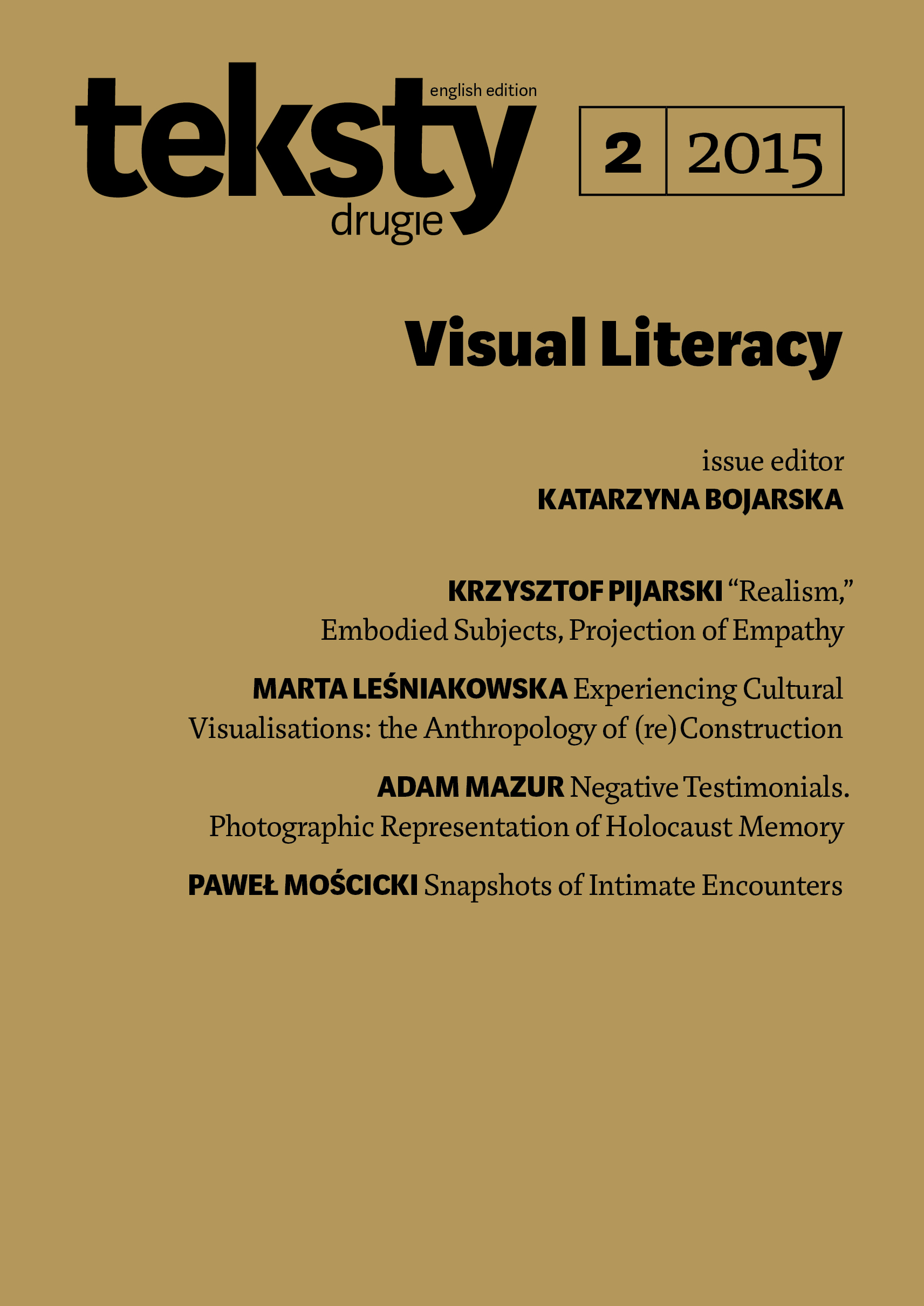

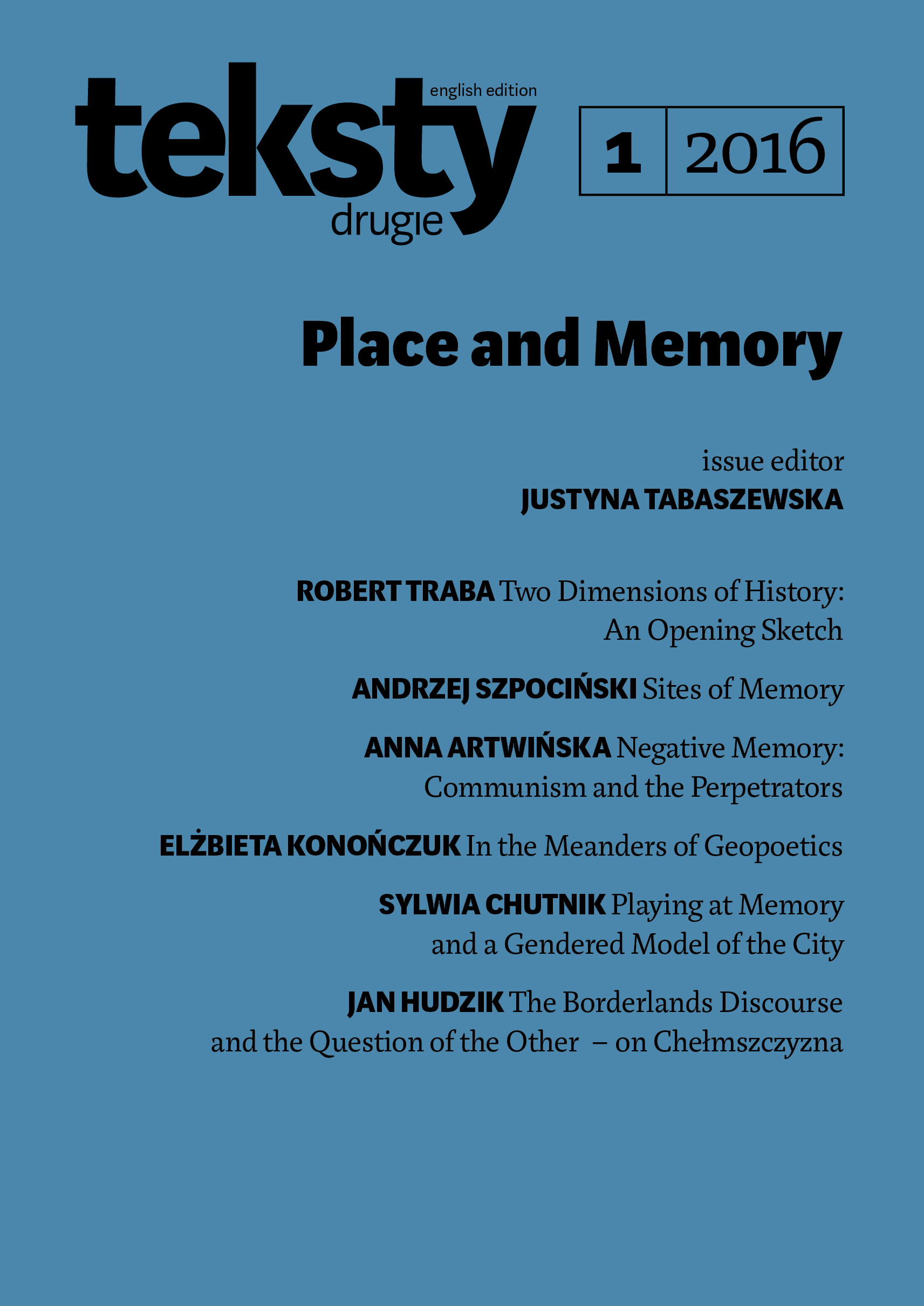
This article concerns the literature of “minor homelands” representing the territories that were included within Poland’s post-1945 borders. Preoccupied with a search of Otherness and with the concept of a multicultural borderland, this literature rose to popularity in the 1990s. Writers associated with it drew on the poetics elaborated in the context of Poland’s so-called borderland literature [literature kresowa] to rediscover traces of German culture that had been erased during the People’s Republic. By drawing on the poetics of retrospective utopia, however, this literature marginalizes the fundamental problem of forced migration. Siewior describes the strategies of masking that ‘migratory gap,’ i.e. the aestheticizing transfers of older (borderland) traditions, the return to the grandparents’ experience, or the reconstruction of the perspective of the Other. These narrative strategies suggest that this literature is unwittingly entangled in dominant discourses of identity and memory – discourses rooted in nostalgic postwar borderland literature.
More...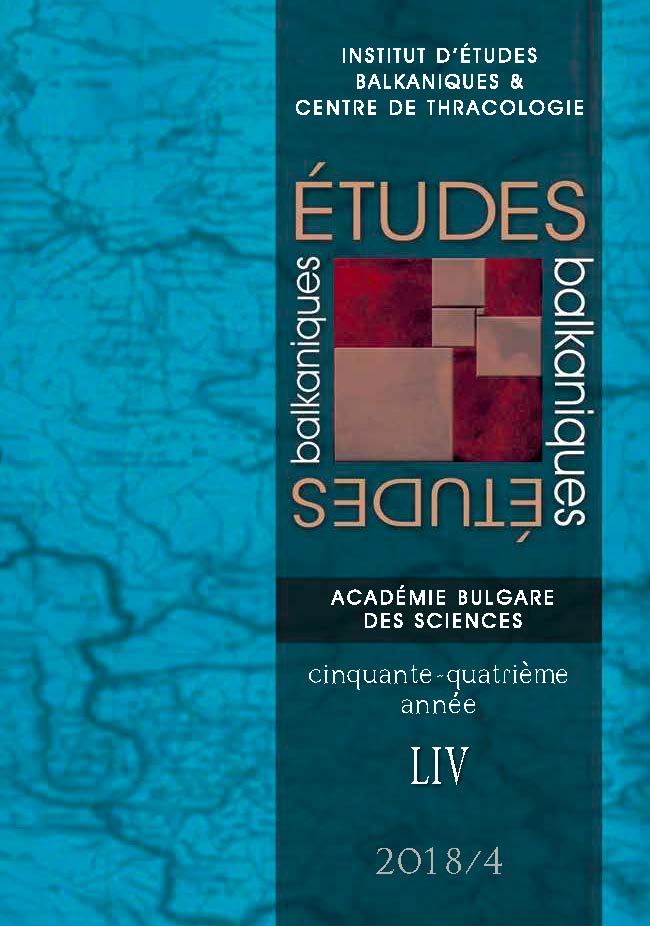
From 2002 to 2015 a considerable number of large-scale, geopolitical bannered exhibitions have been dedicated to the ‘the Balkans.’ This article aims to analyze and compare two types of regional, large scale exhibitions from/on the Balkans: contemporary art exhibitions and interpretative (dedicated to historical and ethnographic themes) exhibitions. The pervasiveness of the stereotypical visual representations of ‘the Balkans’ – called by the Bulgarian artist Luchezar Boyadjiev the ‘Balkan blue’ – as a region of everlasting conflicts and binary oppositions coincides with the birth of contemporary Balkan art. By attempting to overcome the stereotypical images of the Balkans (‘the Balkan ethos’) still prevalent in our days, the travelling exhibition ‘Imagining the Balkans: Identities and Memory in the Long 19th Century’ – opened in Ljubljana (Slovenia) at the National Museum of Slovenia, in April 2013 and then displayed in other national museums of history from the Balkan region – endeavors to place national histories in a perspective where they interact.
More...